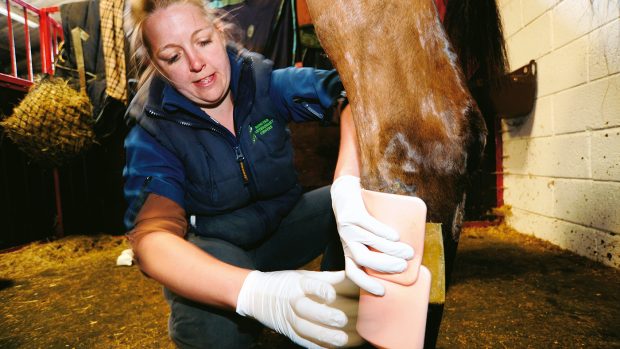A reminder to owners of the vital life-saving help they can give their horse while waiting for the vet has been highlighted at the British Horse Society (BHS) welfare conference.
Redwings’ senior veterinary surgeon Nicola Jarvis spoke about the simple things owners can do to improve a horse’s chances in several emergency situations while the vet is on their way.
“Know your horse,” stressed Ms Jarvis.
“From the moment your horse is in some form of distress, if you can prevent deterioration until the vet arrives, you’re going to do such an amazing thing.”
She added knowing the normal resting breathing rate of your own horse, his heart rate, the colour of his gums and — if safe to take — his temperature is very useful information to be able to tell your vet.
“It is about being able to spot that subtle thing that is still a rip-roaring emergency,” she said.
Ms Jarvis added that your own safety is paramount and advised anyone dealing with an emergency to “hit the pause button” first to make sure they are not taking unnecessary risks.
“A distressed or injured horse will be unpredictable,” she said.
“If you are dealing with a collapsed or seizuring horse, in that moment that horse will not know you — he will not mean to kick you and break your leg, he doesn’t know what he is doing.
“I need you to treat your horse as a strange horse you have never met before — your only safe area is along that horse’s back.
“Before you help your horse, you need a hat on, you get a pair of handling gloves and you get lunge lines so you can be further away. Get a runner to be on the phone to the vet.”
She said for a horse having a seizure “peace and quiet” is essential and warned not to encourage them to stand prematurely.
Bales can be used to support him if he is trying to sit up of his own accord and making a soft non-slippery surface with shavings can help if he is trying to stand on his own.
Article continues below…
You might also be interested in:

Colic: what to do while you wait for the vet
Being a horse owner is an emotional rollercoaster

When should you call the vet for your horse?

When yard accidents turn deadly *H&H VIP*
Taking risks with yard safety can have disastrous
Among the other areas Ms Jarvis covered were:
Atypical myopathy
“Act quickly,” she said, adding that the horse and any others should be brought in off the field as soon as possible.
“The only treatment you can do is supportive, but your vet can do so much more with a horse who is still standing.”
Trapped horse
“Safety first — they will try initially to free themselves,” said Ms Jarvis.
“When they discover they can’t, some stop and even eat. That changes rapidly the second they sense freedom.
“Hit the pause button — get the hat, get the gloves, get the lunge lines.”
Colic
Ms Jarvis recommended that once you have called the vet, have buckets of warm water ready and hitch up the trailer or check the horsebox starts so you have one less job to do should the horse need to be taken in.
She added that while a gentle walk is fine, do not exhaust the horse, who should be allowed to go down if the area he is in “is safe to do so”.
Non-weightbearing lame
“If there is any abnormal movement, do not move the horse — any movement can make it worse,” she said.
She added if there is a foreign object obviously sticking out of a limb or foot, do not remove it where possible, but pad the surrounding area so they do not push it in further.
“Bandaging the supporting limb is something practical you can do,” she said.
Don’t miss next week’s issue of Horse & Hound — out Thursday, 28 September — for more from the BHS welfare conference




